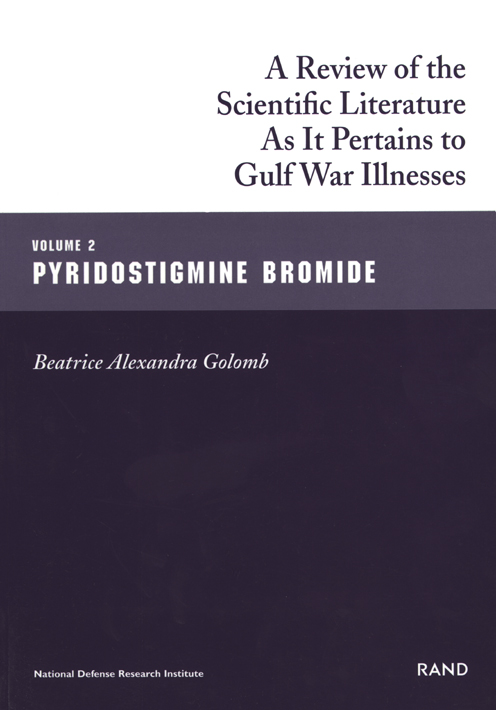
BackgroundChapter Two: Fact Sheet: PB Pretreatment for Soman Exposure
Methods
What Is PB?Chapter Three: Characteristics of PB
How Nerve Agents Work
How Traditional Anti-Nerve Agents Work
Chemical CharacteristicsChapter Four: PB Use in the Persian Gulf War
Medical Use
Military Use
ProductionChapter Five: Health Problems in PGW Veterans
Packaging
Storage
Training and Education
Decision Regarding Use
Use
Other Nations
PB Timetable in the PGW
Summary
Scientific Recommendations
Gulf War Veterans Report Health ProblemsChapter Six: Theories Linking PB to Illness in PGW Veterans
Symptoms in PGW Veterans
Comment on Headache
Increased Symptom Reporting in PGW Veterans
Factors Associated with Registry Participation
Limited Evidence Is Consistent with the Possibility That PB, or Adverse Response to PB, May Be Associated with Illness
Blood-Brain Barrier Passage: Does PB Cross the Blood-Brain Barrier During Conditions of Stress?Chapter Seven: Blood-Brain Barrier Passage
Individual Differences in Response to PB: Do Physiologic Differences Influence Susceptibility to PB?
Interactions with Other Exposures: Do Interactions Between PB and Other Exposures Enhance the Toxicity of Effects?
Bromism: Does Accumulation of the Bromide from PB Produce Bromism?
Multiple Chemical Sensitivity (MCS): Does PB Lead to MCS?
Neuromuscular Junction Effects: Does PB Produce Neuromuscular Junction Changes?
Neurotransmitter Dysregulation: Does PB Alter Regulation of Neurotransmitters, Particularly Acetylcholine?
Chronic Effects
Other Considerations
Comment on PB Doses
Does PB Cross the Blood-Brain Barrier During Conditions of Stress?Chapter Eight: Individual Differences in Reactions to PB
Evidence
Other Research
Discussion
Conclusions
Scientific Recommendations
Summary Analysis
Do Physiologic Differences Influence SusceptibilityChapter Nine: Interactions between PB and Other Exposures
Chemical Findings
Clinical Findings
Relational Findings
Individual Differences in Baseline Cholinergic Status
Individual Differences and Illnesses in PGW Veterans
Limitations
Sources of Individual Differences in Response to PB
Summary Analysis
Do Interactions Between PB and Other Exposures Enhance the Toxicity of Effects?Chapter Ten: Bromism
IOM Approach to Drug/Vaccine Interactions
Matrices of Toxicity
What Can We Learn from Other Populations with Multiple Drug Exposures?
Specific Interactions of PB with Other Factors
Strategy for Testing Drug Interactions
Conclusion
Scientific Recommendations
Does Accumulation of the Bromide from PB Produce Bromism?Chapter Eleven: Multiple Chemical Sensitivity
Symptoms of Bromism
Diagnosis of Bromism
Treatment of Bromism
Causes of Bromism
Mechanism of Bromism
Bromide Levels That Result in Bromism
Low-Level Bromism
Time-Course of Resolution of Bromism
Bromism Due to PB
Long-Term Symptoms
Bromide Interactions
Amount of Bromide in PB Given to PGW Veterans
Bromism as a Cause of PGW Illnesses
Scientific Recommendations
Summary Analysis
Does PB Lead to MCS?Chapter Twelve: Neuromuscular Junction Effects
MCS Case Definition
MCS Etiology
MCS and Illnesses in PGW Veterans
Limbic Kindling: One Proposed Mechanism for MCS
Individual Differences and Interactions
Interactions and Time-Dependent Sensitization
Psychosomatic Versus Organic Disease: One Perspective
Methods of Study
Quantitative Validation
Summary
Scientific Recommendations
Summary Analysis
Does PB Produce Neuromuscular Junction Changes?Chapter Thirteen: Neurotransmitter Dysregulation
Studies with AChE Inhibitors
Conclusions
Limitations in Present Evidence
Scientific Recommendations
Summary Analysis
Does PB Alter Regulation of Neurotransmitters,Chapter Fourteen: Chronic Effects
Particularly ACh?
What Is Downregulation?
Downregulation in the ACh System
Predictions from This Hypothesis
Limitations of the Hypothesis
Other Neurotransmitter Systems
More Complications
Conclusion
Scientific Recommendations
Summary Analysis
Extrapolation of Data from Myasthenia GravisChapter Fifteen: Other Considerations
EEG
Effects on Cerebral Blood Flow
Neuropsychiatric Effects
Psychiatric Disorders Cannot Explain Symptoms in PGW Veterans with Fatiguing Illness
Neurologic Effects: OP-Induced Delayed Polyneuropathy and Intermediate Syndrome
Neurochemical Effects
Relations of Symptoms to Drug Level or Measure
of "Drug Effect"
Relation of Acute to Chronic Symptoms
OverviewChapter Sixteen: Conclusions
Fertility
Hormone and Stress Effects
Catecholamine Effects
Pain
Mood and Behavior
Memory and Cognitive Effects
Dermatologic Findings: Skin Symptoms and Hair Loss
Diarrhea
Sleep
Teratogenicity and Developmental Effects
Pregnancy and PGW
Violent Death (Death from Unintentional Injury)
Defining Cases and Controls for Research on Illnesses in PGW Veterans
Scientific Recommendations
Summary Analysis
Theories of Heightened SusceptibilityAddendum: Evidence for Neurotransmitter Dysregulation Identified or Published Since the Review Process
Theories Concerning Possible Contributions by PB to Chronic Symptoms
Effectiveness
Limitations and Future Directions
Concluding Remarks
All rights reserved. Permission is given to duplicate this on-line document for personal use only, as long as it is unaltered and complete. Copies may not be duplicated for commercial purposes.Published 1999 by RANDRAND is a nonprofit institution that helps improve policy and decisionmaking through research and analysis. RAND's publications do not necessarily reflect the opinions or policies of its research sponsors.